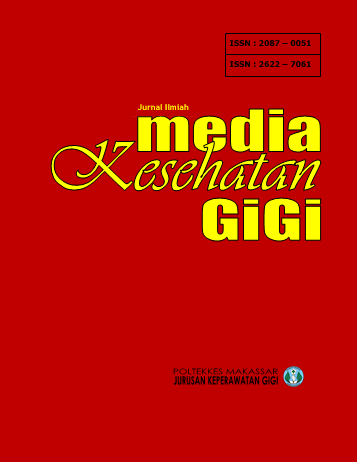The Impact of Malocclusion on Psychosocial Adolescents
DOI:
https://doi.org/10.32382/mkg.v24i1.1449Keywords:
Malocclusion, Psychosocial, Adolescent, High SchoolAbstract
Dental and oral health problems in Indonesia remain quite prevalent, with 57% of the population experiencing issues, yet only 10.2% of them receive treatment. One of the most commonly found problems is malocclusion, which refers to the misalignment of teeth and affects around 80% of the population. This condition negatively impacts daily activities, including psychosocial aspects. Previous studies have shown that malocclusion can affect self-confidence and appearance, thereby requiring special attention in orthodontic care.This study is an analytical observational research, in which the researcher directly observes subjects to identify relationships between two or more variables without administering treatment or intervention. The research design used is cross-sectional, which assesses the relationship between independent and dependent variables at a specific point in time without follow-up. The results of the bivariate analysis using the Chi-Square test indicated that there is no significant relationship between malocclusion and psychosocial conditions among adolescents at SMA Negeri 9 Makassar (p = 0.149). Most respondents had Class I malocclusion, commonly in the form of crowding, but due to low levels of knowledge and awareness, they were less conscious of the social impact of their condition. In line with previous findings, this study concludes that malocclusion does not have a significant impact on adolescents’ psychological condition. All adolescents identified with malocclusion at the school were female, who also showed the highest prevalence.
Downloads
Published
How to Cite
Issue
Section
License
Copyright (c) 2025 Asriawal, Muh Saleh, Baharuddin, Nur Hijriyati Syam

This work is licensed under a Creative Commons Attribution-ShareAlike 4.0 International License.
The authors retain copyright and grant Media Kesehatan Gigi journal the right of first publication with the work simultaneously licensed under a Creative Commons Attribution-ShareAlike 4.0 International License, which allows others to share the work with an acknowledgment of the work's authorship and initial publication in this journal.
pdf (Bahasa Indonesia) downloaded: 164






